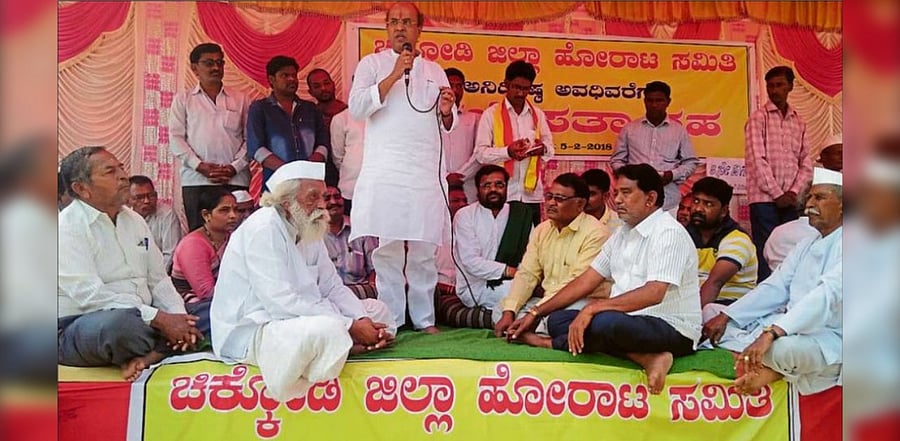
The state government has recently formalised the formation of Vijayanagar, a new district named after the capital of the historic Vijayanagar Empire, by dividing Ballari district. Vijayanagar will Karnataka’s 31st district and this move has revived several long-pending (and a few recent) demands for the creation of other new districts across the state.
The trifurcation of Belagavi district into Chikkodi and Gokak is one such demand, while bifurcation of Tumakuru district to form a new Madhugiri district is another demand seeking Chief Minister B S Yediyurappa’s attention. MLC A H Vishwanath had earlier demanded that Hunsur be separated from Mysuru district and that the new district be named after former chief minister D Devaraj Urs. There have also been demands to separate Jamkhandi from Bagalkot and Sirsi from
Uttara Kannada district.
These demands remain controversial with much scepticism surrounding their motive. For instance, even though the Vijayanagar district has been touted as an administrative solution to a large district like Ballari, it is widely believed that the government’s decision stemmed from political pressure. The new district is seen as Chief Minister B S Yediyurappa’s appeasement of forest minister Anand Singh, who was among the Congress rebels who jumped to BJP in 2019. Singh, a mining baron, is said to have been keen on curtailing the influence of the Reddy brothers to Ballari.
A senior Congress leader said, “Ballari was divided purely for political reasons and not administrative reasons. Of late, demands to divide districts are being made for political reasons with vote bank as the main consideration. Geographically, when a district headquarters falls within 50-60 km from any town, there’s no need to divide the district. Using this parameter, districts like Belagavi and Tumakuru need to be considered on priority for bifurcation. But the government has not acted on it.”
Likewise, the demand for division of Belagavi district is also believed to be an attempt by the politically influential Jarkiholi family to fortify their control over the region, which also has other politically affluent families, such as the Hukkeris and Jolles among others. Vishwanath’s demand is seen as his attempt to thwart Siddaramaiah’s influence and regain his political clout in the region. Both leaders are from the Kuruba community.
From an administration point of view, Belagavi and Tumakuru are huge districts which merited bifurcation, according to an IAS official. “In general, smaller districts with not more than four taluks are preferable for administrative ease. However, politics is taking precedence over development and district bifurcation is not scientifically planned,” the official told DH.
Even with a large district, such as Belagavi, the public and political aspirations of several groups are in conflict with each other. While there are calls for trifurcation of Belagavi by carving out two new districts --- Chikkodi and Gokak --- some local groups feel such a decision would flare up the Maharashtra-Karnataka border dispute. “At a time when the border dispute remains unresolved, the division of the district would only help organisations, such as the Maharashtra Ekikaran Samithi to exert control over the region,” said Ashok Chandaragi, president, Belagavi District Kannada Organisations Action Committee. The committee has been actively protesting against this division, ever since it was first proposed during J H Patel’s regime in 1997, he added.
The last time the state saw an extensive reorganisation of districts was during Patel’s tenure as the chief minister. At that time, seven new districts were created - Bagalkot, Udupi, Davangere, Chamarajnagar, Koppal, Gadag and Haveri. Later, during HD Kumaraswamy’s regime in 2007, Ramanagara and Chikkaballapur districts were carved out. Yadgir was the last district created in 2009 during Yediyurappa’s earlier tenure as the chief minister.
The reorganisation of districts needs to be done through a committee, based on a detailed study. The policymakers need to have a rationale for splitting the districts. It cannot be done in a piece-meal manner, political analyst Sandeep Shasthri said. When politics take the front seat in this process, it leads to the creation of unviable districts, he added.
The creation of new districts needs to be coupled with a political will for development. Otherwise, it is counter-productive, senior JD(S) leader Basavaraj Horatti pointed out.
While smaller districts are helpful in bringing the district headquarters closer to people and is helpful in getting more funds, it is futile without the political will to make use of the allocation, he said citing the instance of several districts in North Karnataka still perceived to be “backward” in development.

